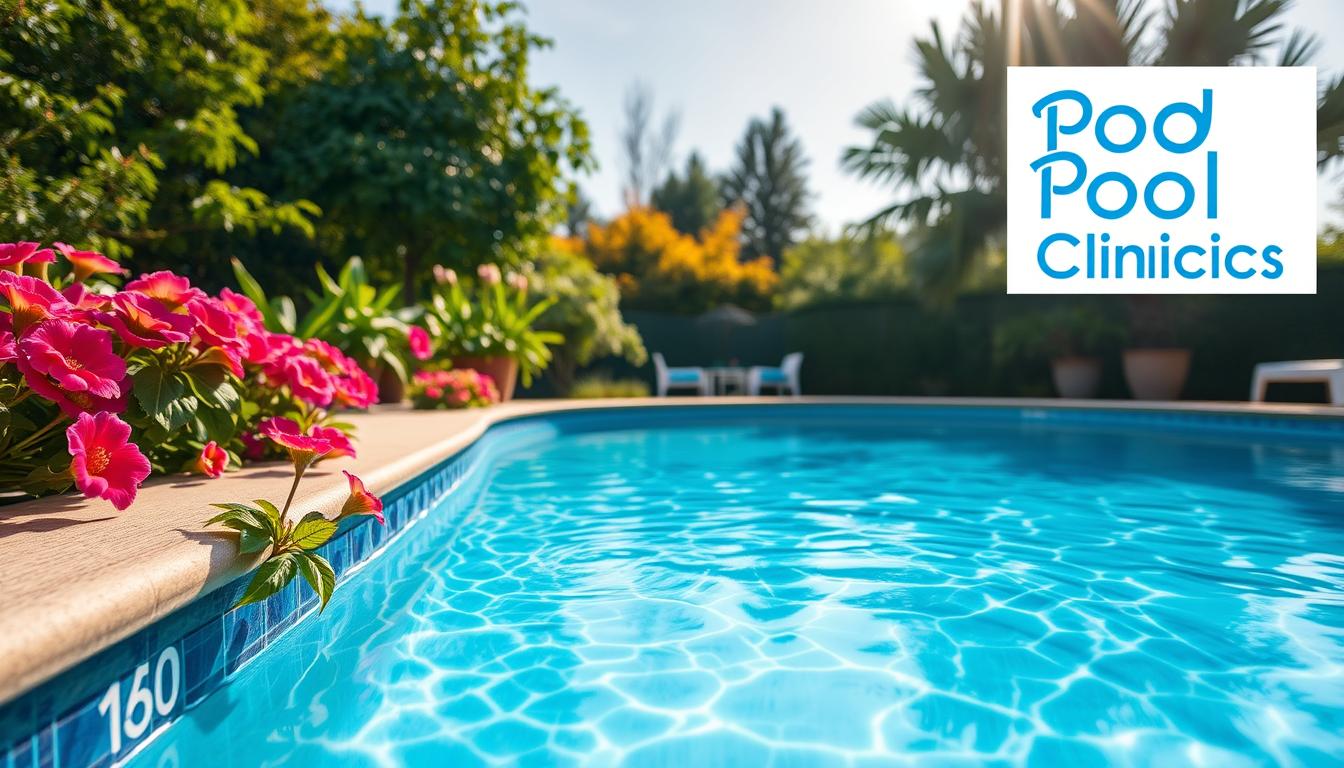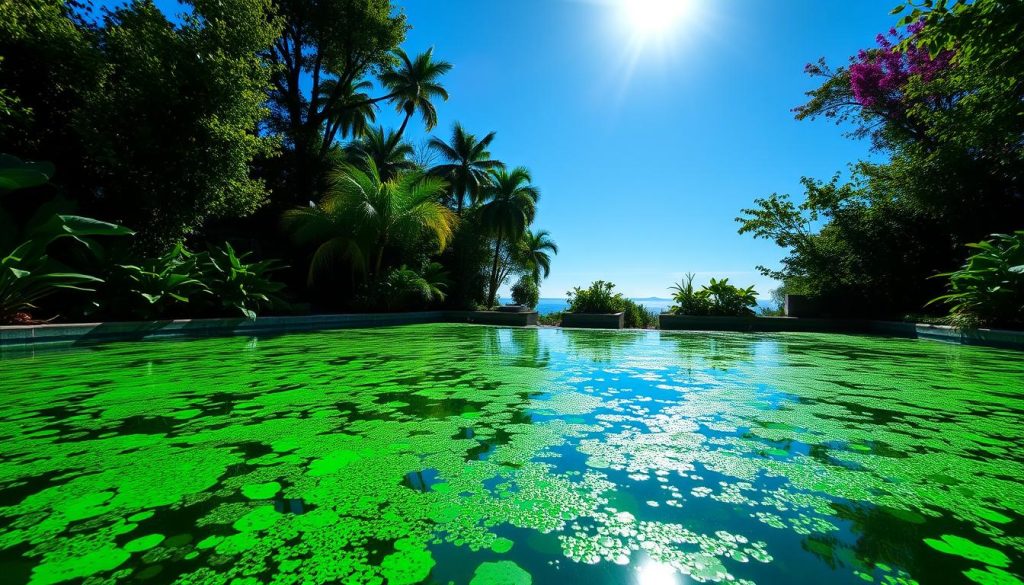
Pool owners know clean water is vital for family and guests. Shock treatment eliminates contaminants, bacteria, and algae. But how long should we wait before swimming after shocking the pool?
The wait time varies based on several factors. Pool size, shock type, and water chemistry all play a role. It’s crucial to understand these elements for proper pool care.
Typically, it takes 2-3 days of continuous filtering for water to clear. However, experts recommend waiting at least 24 hours before swimming. This precaution helps avoid skin and eye irritation.
Different types of shock affect dissipation time differently. Understanding these variations ensures your pool stays crystal clear. It also keeps swimmers safe and comfortable.
Key Takeaways
- Shock treatment is essential for maintaining clean and hygienic pool water
- Pool shock dissipation time depends on factors like pool size, type and amount of shock used, and water chemistry
- It typically takes 2-3 days of continuous filter running for the water to clear after shocking
- Wait at least 24 hours before swimming after shocking to avoid skin and eye irritation
- Understanding the types of shock and factors affecting dissipation time is crucial for proper pool maintenance
Understanding Pool Shock Treatment
Pool shock treatment keeps swimming environments clean and safe. It’s crucial for pool owners to grasp the basics of pool shocking. This knowledge ensures optimal pool condition throughout the swimming season.

What is Pool Shock?
Pool shock is a concentrated form of chlorine or other oxidizing agents. It rapidly raises the level of free chlorine in a pool. Free chlorine actively eliminates contaminants like bacteria, algae, and organic matter.
Shocking a pool involves adding a high dose of shock to the water. This quickly destroys unwanted elements and restores the pool’s clarity and sanitation.
Importance of Shocking Your Pool
Regular pool shocking is essential for several reasons:
- Maintains water clarity by preventing algae growth and removing organic contaminants
- Ensures a safe and healthy swimming environment by eliminating harmful bacteria and other pathogens
- Helps maintain proper chlorine levels, which can be depleted by factors such as sunlight, heavy pool usage, and rainfall
- Prevents the formation of chloramines, which can cause irritation to swimmers’ eyes and skin, as well as produce unpleasant odors
Pool owners should follow proper pool shock guidelines. Adhering to recommended pool shock dosage achieves the best results. This practice maintains a safe swimming environment.
Types of Pool Shock
Several types of pool shock are available. Each has its own characteristics and benefits:
| Type of Shock | Active Ingredient | Characteristics |
|---|---|---|
| Calcium Hypochlorite (Cal-Hypo) | 65-75% available chlorine | Highly effective, but can raise calcium hardness levels |
| Sodium Dichlor (Di-Chlor) | 56-62% available chlorine | Fast-dissolving, contains cyanuric acid for chlorine stabilization |
| Lithium Hypochlorite | 35% available chlorine | Fast-acting, does not affect pH or calcium hardness |
| Potassium Monopersulfate (Non-Chlorine Shock) | Oxygen-based oxidizer | Chlorine-free, effective for removing contaminants, but does not sanitize |
Choose the right shock for your pool and follow proper application guidelines. This approach effectively maintains a clean, clear, and safe swimming environment. Your pool will stay in top shape throughout the season.
Factors Affecting Shock Dissipation Time
Several factors impact how long shock takes to clear a pool. Understanding these can help us manage pool maintenance better. It ensures a safe and fun swimming experience for all.
Pool Size and Volume
Pool size and volume are key in determining shock dissipation time. Larger pools need more shock to reach desired chlorine levels. This takes longer to clear.
It’s vital to accurately calculate your pool’s volume. This helps determine the right amount of shock needed.
Type and Amount of Shock Used
The type of shock you use greatly affects dissipation time. Various pool shock types exist, each with unique characteristics. These include calcium hypochlorite, lithium hypochlorite, and dichlor.
Cal-hypo dissolves quickly and raises water calcium hardness. Lithium hypochlorite dissolves more slowly but doesn’t affect calcium levels.
The amount of shock used also impacts dissipation time. Over-shocking can lead to high chlorine levels. This can irritate skin and eyes and extend clearing time.
Water Chemistry and Temperature
Your pool’s water chemistry can affect shock dissipation time. Ideal pH levels for pools range from 7.2 to 7.8. Cyanuric acid levels should be between 30 and 50 ppm.
Water temperature influences shock dissipation too. Warmer water makes chlorine dissipate faster. You may need to shock more often in summer.
Cooler water slows down the dissipation process. This allows the shock to remain effective longer.
| Factor | Impact on Shock Dissipation Time |
|---|---|
| Large Pool Volume | Increases dissipation time |
| Small Pool Volume | Decreases dissipation time |
| Cal-Hypo Shock | Faster dissipation |
| Lithium Hypochlorite Shock | Slower dissipation |
| High pH Levels | Reduces shock effectiveness, prolongs dissipation |
| Ideal pH Levels (7.2-7.8) | Optimal shock performance |
| High Water Temperature | Faster chlorine dissipation |
| Low Water Temperature | Slower chlorine dissipation |
Consider these factors and maintain proper water chemistry. This optimizes shock treatment and minimizes pool clearing time. It’s crucial after rain or events requiring shock treatment.
How Long Does It Take for Shock to Clear a Pool?
Pool shock needs time to dissipate before swimming. The time it takes varies based on several factors. Let’s explore the guidelines for a safe swim after shocking your pool.
General Guidelines for Waiting Times
It’s best to wait at least 24 hours after shocking a pool before swimming. This allows the shock to eliminate contaminants and stabilize chlorine levels.
The waiting time may vary depending on pool size and shock type. In some cases, you might need to wait up to a week for potent treatments.
Testing Chlorine Levels Before Swimming
Always test the pool water’s chlorine levels before swimming. The ideal chlorine level should be between 1 and 3 parts per million (ppm).
The pH should range from 7.2 to 7.8. If chlorine levels exceed 4 ppm, wait longer to avoid skin and eye irritation.
Regular testing and balancing ensure a safe swimming environment. This practice is crucial, especially after a shock treatment.







